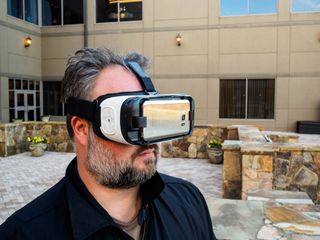How the Galaxy S7 and S7 edge perform in the Gear VR

If you've used the Samsung Gear VR on anything before the launch of the Galaxy Note 5, you know Samsung's VR experience is really great right until it isn't. Early models overheat frequently, several of the more demanding VR experiences aren't even available on those early models, and the Galaxy S6 could be drained to dead in under an hour in VR. Things got a lot better with the Note 5, and now that Samsung is hooking so many people up with free Gear VR there's an expectation that the experience will continue to improve with the Galaxy S7 and S7 edge.
The good news is things are absolutely better with these new phones. The OK news is those differences aren't all dramatic or significant.

We've gotten a lot of questions about Samsung's new phones in the Gear VR, but the most frequently asked question has been about the display. Samsung's displays in the Galaxy S7 and S7 edge are slightly better than the Galaxy S6 and Note 5, but in VR things get split up and held under a magnifying glass. The resolution is the same between these two phones, which means there are more pixels per inch on the Galaxy S7 than there are on the S7 edge.
What this means in real world usage is sometimes text is a little sharper on the Galaxy S7, but just about everything else is the same. In some apps you'll notice the curved display on the S7 edge causes some light aberrations on the top and bottom of the images you're viewing, but you have to actively look for them to see them and even then it's only when bright whites are shown in the top and bottom. In things like gameplay or video, you'd never know these phones were any different from one another, or the Note 5 for that matter.
As Samsung continues to work with Oculus on things like Vulkan APIs, it's likely we'll see the Gear VR become both more efficient and more capable over time.
Next up is overheating, which is a big problem for a lot of people using the Gear VR. With the Galaxy S6 and Note 5 it's a lot harder to get the overheat warning to pop-up under normal use, but it's not impossible. Any intense game while the power is connected, for example, will quickly cause things to get out of hand. We've only tested the Galaxy S7 and S7 edge in Qualcomm Snapdragon 820 form so far, but there's a noticeable difference in performance. Playing through a level in Eve: Gunjack on the Note 5 causes the whole phone to get warm, and understandably so. That same session on the Galaxy S7 edge causes a significantly lower buildup of heat, due largely to the more capable processor. You're still going to run into the occasional heat warning if you try charging the phone while playing the more interactive games, but overall it's a significant improvement.
Finally, the larger battery and the more capable processor in the Galaxy S7 and S7 edge make a noticeable difference in use over time. On the Galaxy Note 5, 20 minutes of Eve: Gunjack consumes about 15 percent of the total battery on the phone. That's not bad considering the nearly 30 percent we'd see with the Galaxy S6, but on the Galaxy S7 edge that number drops down to 10 percent. Meanwhile, the smaller Galaxy S7 consumes closer to 13 percent in our tests. This is maximum brightness on LTE with none of Samsung's power saving features on, which is a huge increase in overall performance.
The best part about all of these performance changes is it's just the start. As Samsung continues to work with Oculus on things like Vulkan APIs, it's likely we'll see the Gear VR become both more efficient and more capable over time. We'll be conducting a full review of the Galaxy S7 in the Gear VR over the next few weeks, so be sure to drop any questions you have in the comments below!
Be an expert in 5 minutes
Get the latest news from Android Central, your trusted companion in the world of Android

